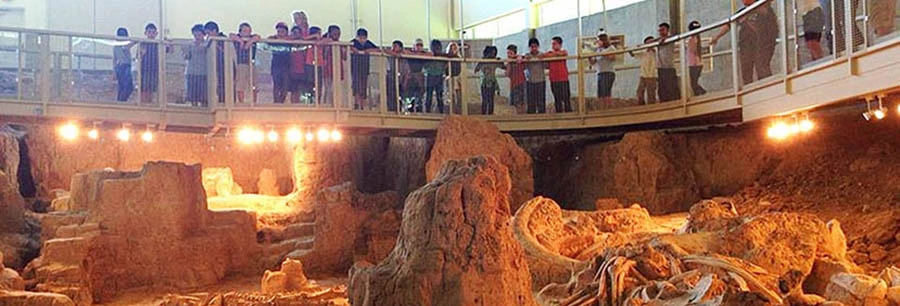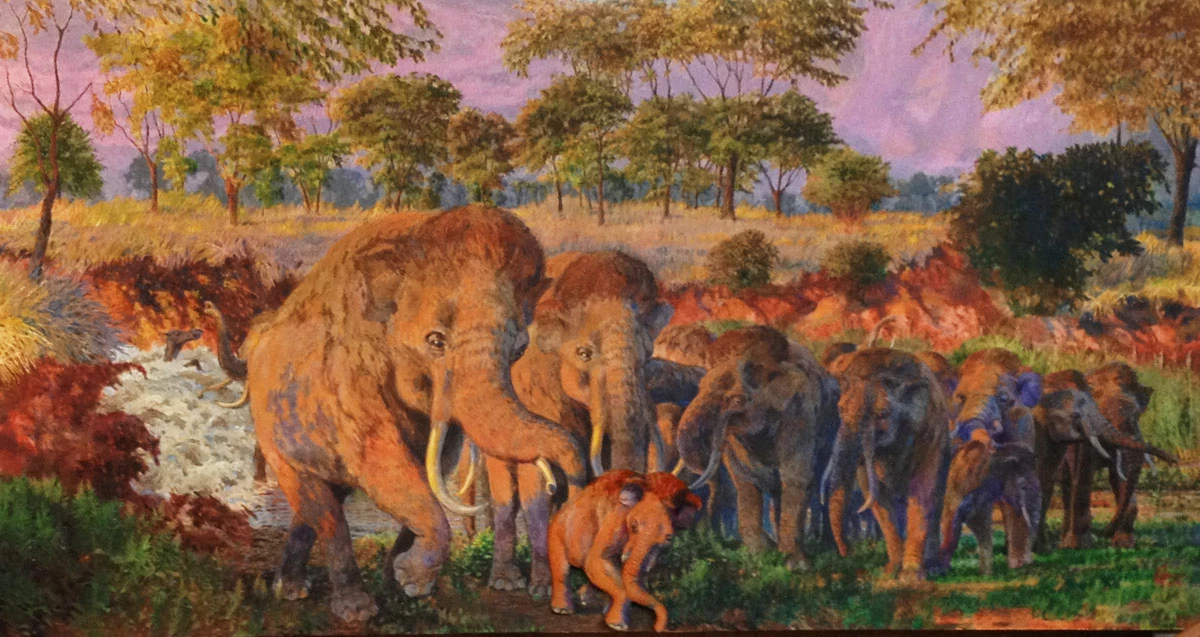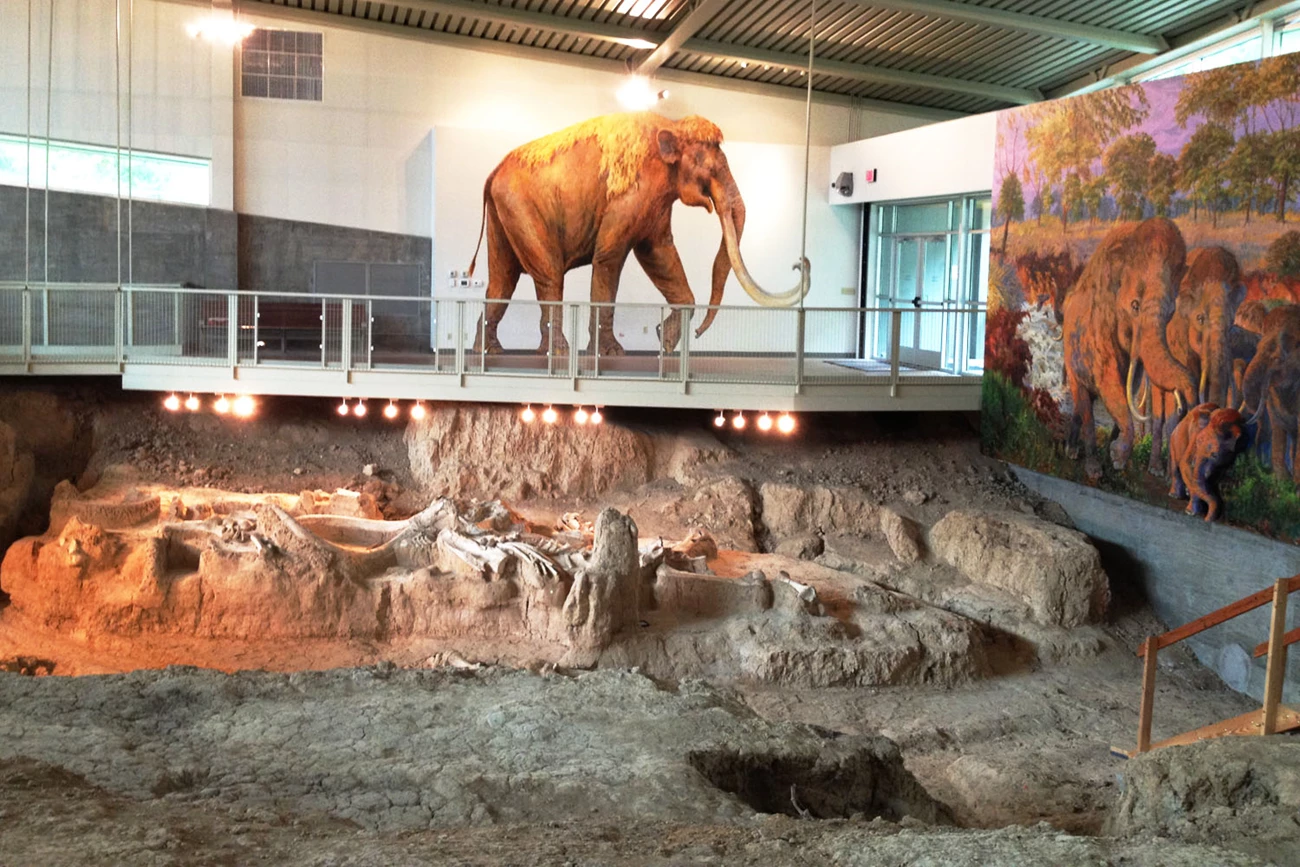Part of a series of articles titled Park Paleontology News - Vol. 11, No. 1, Spring 2019.
Article
Bringing The Past Alive: Mammoth Behavior Seen Through Waco Mammoth National Monument and its Impact on Interpretation

Article by Mason Bozzo, Waco Mammoth National Monument

NPS Photo
The mammoths of Waco Mammoth National Monument have undoubtedly changed the way people view these Ice Age creatures. Through the discovery of the first and only Columbian mammoth nursery herd, the public is provided a glimpse of what life was like for these animals through their habits and social structure. This structure resembles that of our modern elephants, providing us with a more comprehensible picture of an animal that no person today has ever seen alive. With this perspective added to our previous understanding of mammoths, the implications of the Waco Mammoth discovery give us the opportunity to showcase these creatures in a way that is more lifelike and relatable to the average visitor by drawing on their prior knowledge of modern elephants to form a connection with the past. When a connection like this is made, it enables a deeper understanding of the material and inspires visitors to create their own meaning from the site based on their own experiences and knowledge. By interpreting the implications of this exceptional find, visitors have the chance to not just be “told” about an animal, but to understand it's motivations and what it's life was like.
We know that modern elephants are highly social animals. Therefore, it is not a surprise to discover the same is true for our mammoths. Finding a nursery herd, a group of mothers banding together to raise their young, seems to be a logical solution to satisfy their need for interaction. But a herd also has more practical applications, such as protection. The Ice Age was not for the faint of heart; with massive creatures and often scarce resources, our mammoths were constantly on the lookout for predators who might pick off their young, sick, or unmindful. Traveling in larger numbers made them a more difficult target, which discouraged many of their would-be attackers, and generally led to a longer lifespan. Because of this, female mammoths traveling in these groups could easily live to be 75 years old, but a male traveling alone could only hope to see his early forties.

Photo courtesy of Lee Jamison
By looking at these numbers, it would make more sense for the bull (adult male) mammoths to stay with the herd as well, but that is not the case. With modern elephants, typically any males seen in a herd are less than thirteen years old, and as many mothers and fathers can attest, as soon as a young male reaches puberty their behavior changes at an exceptional speed regardless of the species in question. For elephants, this means they begin to exhibit more aggression and territoriality, which are dangerous characteristics to have around infants. When this change occurs, the mothers typically drive the males out of the herd for the safety of the young. It appears that mammoths shared a similar experience. Even using the only bull mammoth from our site (Mammoth Q) as a reference, there is quite a bit of evidence pointing to males being just as aggressive as their modern relatives. This is seen through evidence of a broken rib, which is a common fighting injury for elephants who fight by swinging their tusks at their opponent’s midsection. This aggressive nature would easily explain why the males traveled alone, even though it meant a more dangerous lifestyle.
In addition to having a social nature, we see that our females were very protective and highly empathetic animals. Normally, traits like these would be difficult to distinguish through looking at bones, but fortunately the majority of the herd found at Waco mammoth was still in its original arrangement, which allows us to get a “snapshot” of their final moments. When the bones were uncovered, it was noticeable that the juveniles were close to the center of their group, while the females’ bones formed a circle around them, facing outward, in apparent expectation of danger. This is a typical defensive position, and shows a maternal instinct within the group. In addition, three of these juveniles were found with their bones stretched across the tusks of their mothers, which is thought to be a result of the females’ attempt to lift them free from the floodwaters. This is the tragic side of our site. While this find gives an opportunity to learn more about animals from a long-gone era, pictures like these tend to humanize the past and pull at the heartstrings of the visitors.

NPS Photo
When interpreting sites like this, it is important to provide not only an authentic picture of our mammoths’ appearance and biology, but obviously their behavior as well. For many of our visitors, the “behavior” component demonstrated here is the piece that helps them form a meaningful and long-lasting connection to the site, transforming these animals in their mind from an inky, intangible concept to a species as lively as any they have ever seen. These types of meaningful connections also unconsciously stimulate our visitors through what is known as the “Cognitive Map Theory”. Simply put, if information is presented in a way that the learner cannot draw on his or her past knowledge, the information will be seen as irrelevant or unnecessary and the brain will decline to process and store the information. By showing behavioral parallels to modern animals like elephants, visitors are able to build upon the knowledge already stored in their brains to better understand and remember the material. Therefore, the nursery herd discovered here at Waco Mammoth provides a novel reminder for many National Park sites to keep provoking a higher level of engagement in their visitors through a renewed focus on animal behavior.
Last updated: April 23, 2020
